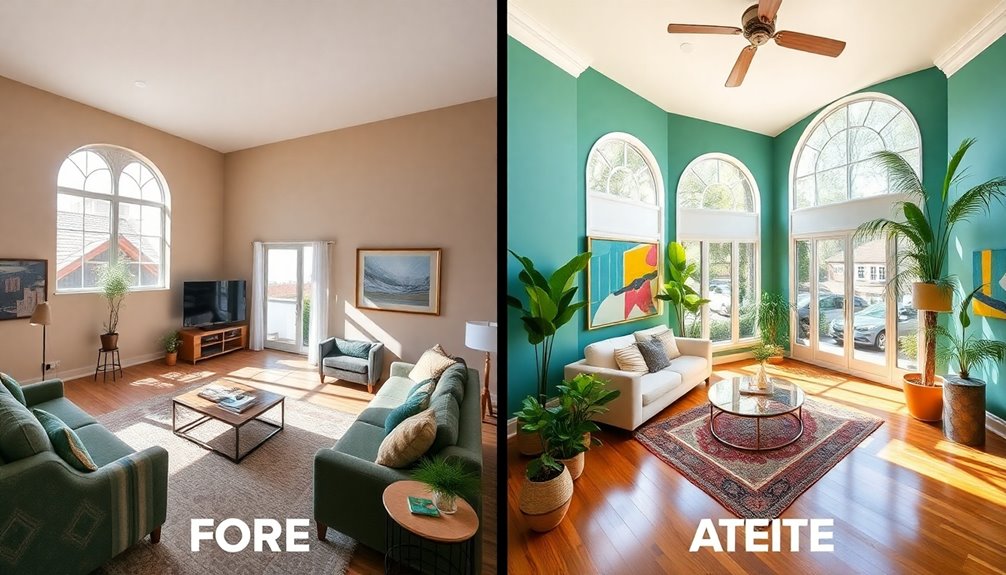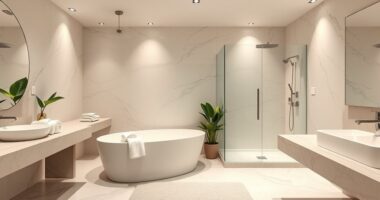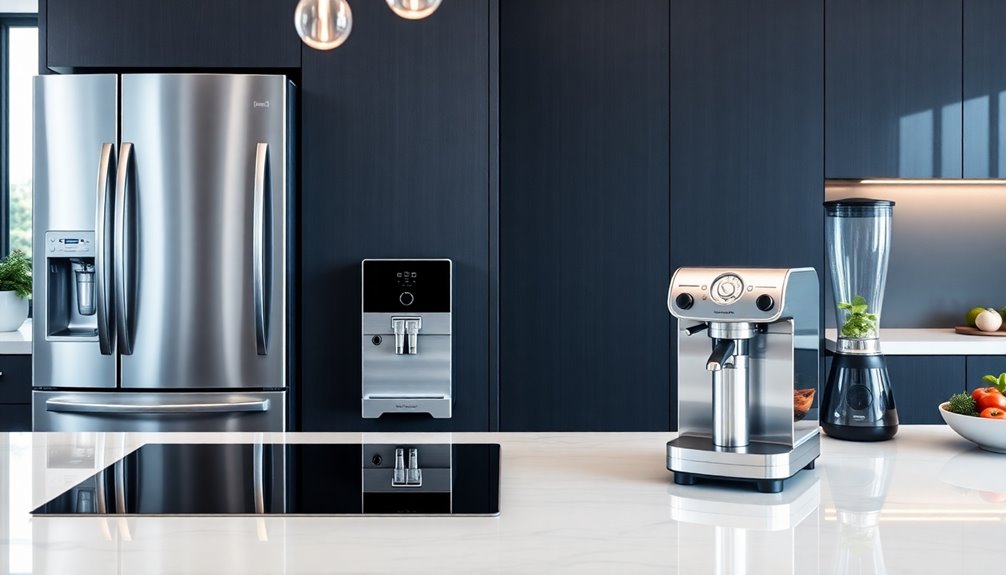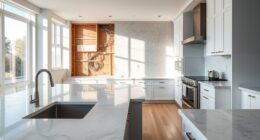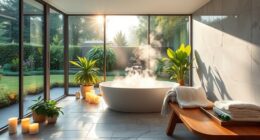To transform your old home into a modern masterpiece, start by evaluating its condition and identifying outdated features. Create a thorough design plan that incorporates fresh colors, energy-efficient upgrades, and modern layouts. Enhance your home’s exterior with trendy paint and landscaping to boost curb appeal. Inside, maximize space with open floor plans and multi-functional furniture. Don’t forget about lighting; quality fixtures can brighten any room and highlight your design choices. By prioritizing sustainable upgrades, you’ll save on costs while making a positive impact. There’s much more to explore, so keep going to discover additional tips and inspiration! Consider transformative home remodel ideas such as adding a statement piece, like a modern fireplace or a sleek kitchen island, to elevate the overall look of your home. Additionally, incorporating smart home technology can bring your old home into the 21st century, with features like automated lighting, thermostat control, and security systems. These innovative upgrades will not only modernize your home but also improve its functionality and efficiency. Don’t be afraid to think outside the box and get creative with your transformation!
Key Takeaways
- Conduct a thorough home assessment to identify outdated features and prioritize necessary repairs for an effective renovation plan.
- Upgrade to energy-efficient appliances and windows to reduce utility costs and enhance sustainability in your home.
- Embrace open floor plans and multi-functional furniture to optimize space and create a modern, free-flowing atmosphere.
- Revitalize the exterior with trendy colors and landscaping to boost curb appeal and increase property value.
- Integrate smart technology for convenience and security, enhancing the overall living experience in your transformed home.
Assess Your Home's Condition

Evaluating your home's condition is essential for a successful transformation. Start by conducting a thorough inspection to identify outdated features and structural issues that need immediate attention. Document any wear and tear, like peeling paint or damaged flooring, as this can guide your renovation decisions and help you allocate resources effectively.
Next, assess your home's condition by checking the energy efficiency of your current systems and appliances. Outdated models can greatly increase your utility costs and impact the environment. If your appliances are old and inefficient, consider upgrading to energy-efficient appliances that can save you money in the long run. By incorporating energy-efficient technology, you can further enhance your home's sustainability and reduce overall costs. Additionally, upgrading to a smart toilet can significantly contribute to water conservation while enhancing comfort and hygiene. Regular maintenance of your heating systems can also improve energy efficiency and prevent costly repairs. Installing a wood pellet stove can provide an eco-friendly heating option that lowers energy consumption.
Creating a checklist of necessary repairs and upgrades will keep you organized and focused during the renovation process. Prioritize your findings based on urgency and budget constraints to guarantee you tackle the most critical areas first.
This assessment provides a solid baseline for future improvements, allowing you to measure progress and make informed decisions throughout your renovation journey. By taking these steps, you'll set the stage for a successful transformation, ensuring that no critical areas are overlooked.
Develop a Comprehensive Design Plan

Creating a thorough design plan is essential for transforming your home effectively. This plan serves as a roadmap for your renovations, aligning your vision with practical execution and guaranteeing all aspects of the project are considered.
To kick off your design journey, gather inspiration from design magazines and online platforms. Visual references can greatly enhance your creative process and help you stay updated on current design trends that suit modern living. Additionally, consider creating a mood board to visualize your design concepts and streamline your decision-making.
Here are some key steps to include in your design plan:
- Consult with professionals: Get insights from designers to avoid common pitfalls.
- Sketch your ideas: Visualizing outcomes aids communication with contractors.
- Align with your style: Confirm your design respects the home's architectural integrity.
- Consider developing a functional layout that maximizes space and enhances the flow of your home.
Enhance Your Home's Exterior

After establishing a solid design plan for your home's interior, it's time to shift focus to the exterior, where first impressions matter. Enhancing your home's curb appeal is essential in transforming it into a modern masterpiece.
Start by revitalizing the exterior with trendy colors; a fresh coat of paint can increase your property value by up to 10%.
Consider replacing old windows with energy-efficient models. Not only will they boost your home's aesthetics, but they can also cut heating and cooling costs by 15-30%. Additionally, installing heat pumps can further enhance energy efficiency, potentially reducing electricity costs by 30-50%. Investing in energy-efficient appliances can complement these upgrades and further lower utility bills. Moreover, incorporating a wood stove can provide an eco-friendly heating solution, enhancing sustainability while reducing energy expenses.
For landscaping, opt for native plants and decorative features, which can yield a return on investment of 100-200% while elevating the overall exterior appeal.
Upgrading your roof with modern materials, like metal or dark shingles, can extend its lifespan by 40 years and enhance visual impact.
Finally, don't overlook outdoor lighting. Installing it not only provides safety but also creates a welcoming atmosphere, making your home 20-30% more appealing to potential buyers. Incorporating natural elements in your landscaping can further promote tranquility and enhance your home's overall aesthetic.
Modernize Interior Spaces

To modernize your interior spaces, start by embracing open floor plans that encourage a free-flowing atmosphere. Incorporate functional storage solutions to keep clutter at bay while enhancing your home's style. Additionally, utilizing natural materials like wood and metal can elevate the aesthetic and warmth of your home. Antiques can also serve as unique pieces that add character and charm to a modernized space. Consider integrating tropical elements in your design, as they can create a harmonious connection with nature. Finally, invest in quality lighting choices that not only brighten your space but also highlight its best features. Additionally, consider integrating smart bathroom technologies that enhance comfort and convenience, transforming your bathroom into a luxurious retreat.
Embrace Open Floor Plans
Embracing open floor plans can transform your home into a brighter, more inviting space. By removing non-structural walls, you enhance the flow of natural light and create a seamless connection between your living, dining, and kitchen areas.
This renovation not only makes your home feel larger but also fosters a social atmosphere where family and friends can interact more freely.
Here are some benefits of adopting an open floor plan:
- Maximized natural light: Large windows and sliding glass doors allow sunlight to flood your interior, uplifting the mood and aesthetics of your home.
- Flexible spaces: Multi-functional areas accommodate various activities without feeling cramped, making your home more versatile.
- Higher resale value: Many contemporary buyers appreciate the appeal of open layouts, which can lead to a better return on investment when it's time to sell.
Functional Storage Solutions
Transform your home into a more organized oasis by implementing functional storage solutions that modernize your interior spaces.
Start by integrating built-in shelving and cabinetry, which maximizes vertical space and keeps your rooms looking sleek and contemporary. Multi-functional furniture, like ottomans with hidden storage or beds with drawers, is another fantastic way to minimize clutter and enhance your living environment. Consider incorporating cozy textiles like blankets and throws in your storage solutions for added warmth and comfort. Additionally, using durable materials in your furniture can ensure longevity and practicality. Portable fire pits can also serve as stylish outdoor storage when they're not in use.
Don't overlook under-stair storage solutions; these often-neglected areas can become stylish and efficient for storing books, shoes, or seasonal items.
In the kitchen, consider open shelving to provide practical storage for dishes and cookware while also allowing you to showcase decorative items that elevate the design aesthetic. Additionally, incorporating space-saving smart solutions can further enhance the functionality of your home and help maintain an organized atmosphere.
Quality Lighting Choices
Quality lighting choices can significantly elevate your home's ambiance and functionality. By utilizing layered lighting strategies, you can create a versatile environment that adapts to your needs.
Incorporating ambient, task, and accent lighting allows you to customize the mood and usage of each space, giving your home a modern flair. Additionally, integrating smart lighting systems can enhance energy efficiency and provide greater control over your lighting preferences. Air purifiers can complement this modern approach by improving indoor air quality, creating a healthier living environment. Moreover, investing in best home security systems can further ensure the safety and peace of mind that complements your stylish updates.
Consider these essential lighting elements:
- Energy-efficient LED fixtures: These reduce energy consumption by up to 75% and last up to 25,000 hours, making them an eco-friendly choice.
- Natural light enhancement: Installing large windows or skylights boosts natural light, improving mood and productivity while minimizing reliance on artificial lighting during the day.
- Smart technology: Emphasize the use of dimmers and smart controls to adjust brightness levels, allowing you to create dynamic atmospheres for different occasions. Additionally, incorporating HEPA filtration in your home can further enhance indoor air quality, making your living environment not only stylish but also healthier.
Selecting a cohesive color palette for your fixtures and finishes can unify your spaces, with neutral tones fostering a contemporary look that complements various design styles.
Optimize Lighting and Color Schemes

To create a welcoming atmosphere in your home, start by maximizing natural light through large windows and strategic placement of mirrors.
Layering your lighting with a mix of ambient, task, and accent options will enhance both functionality and mood in every room.
Finally, choose a cohesive color palette that balances neutral tones with bold accents to unify spaces and make them feel larger.
Maximize Natural Light
When it comes to maximizing natural light in your home, thoughtful design choices can make all the difference. By focusing on a few key areas, you can enhance brightness, create a more inviting atmosphere, and reduce your reliance on artificial lighting.
- Install large windows: They can increase natural light by up to 50%, making your space feel more open and airy. Additionally, consider incorporating energy-efficient motors in your ceiling fans to further enhance airflow while maintaining a bright environment. Effective ventilation through natural air circulation also helps in creating a fresher atmosphere.
- Use mirrors strategically: Placing mirrors opposite windows reflects daylight, amplifying the light throughout the room and enhancing overall brightness.
- Opt for light, neutral color palettes: These tones reflect light better, contributing to a brighter ambiance and making spaces feel larger. Choosing colors like soft blues and greens can promote a calming effect, further enhancing the overall aesthetic.
Regularly updating your lighting fixtures, like switching to recessed LED lights, can also improve energy efficiency while elevating your home's aesthetic. Additionally, consider incorporating ceiling fans with lighting, as they can provide both cooling and illumination, enhancing the overall brightness of the room.
With these changes, you'll not only maximize natural light but also create a modern masterpiece that feels fresh and welcoming. Embrace these design elements to transform your space into a bright and beautiful haven.
Layered Lighting Strategies
Layered lighting strategies can dramatically transform your home's atmosphere by combining ambient, task, and accent lighting. This approach enhances functionality while creating an inviting atmosphere.
Start with ambient lighting to provide overall illumination, then add task lighting in areas like kitchens or reading nooks for focused brightness. Finally, incorporate accent lighting to highlight artwork or architectural features, adding depth and character.
Consider using dimmable LED fixtures, which allow you to adjust light intensity based on your mood or the time of day. This not only promotes energy efficiency but also adds versatility to your lighting design.
During the day, maximize natural light through large windows or skylights, reducing dependence on artificial lighting and further enhancing energy efficiency. Additionally, use similar flooring materials to create continuity between indoor and outdoor spaces, further enhancing the overall ambiance.
Don't forget the power of mirrors! Strategically placing mirrors can reflect light, making spaces feel larger and brighter. This optimizes both natural and artificial lighting sources, creating a more open feel.
Cohesive Color Palette
Creating a cohesive color palette is essential for establishing a unified and inviting atmosphere in your home. By selecting a unified range of colors that complement each other, you create a harmonious flow that enhances your space's overall visual appeal.
Start with neutral tones like whites, grays, and beiges as your foundation, and then add bold accent colors to inject personality without overwhelming the area.
Consider these key points for optimizing lighting and color:
- Choose colors that evoke the desired mood; blues and greens for calmness, yellows and oranges for warmth.
- Select lighting fixtures that match your color palette to maintain a contemporary look and guarantee spaces feel connected.
- Pay attention to color temperature; warm white (around 2700K) creates a cozy atmosphere, while cooler white (around 5000K) enhances clarity and focus.
Explore Smart Home Technology

In today's fast-paced world, exploring smart home technology can greatly enhance your living experience. Imagine controlling your home's security with smart locks and cameras, all from your smartphone. You can monitor your property remotely, ensuring peace of mind whether you're at home or away.
Energy management systems, like smart thermostats, optimize your heating and cooling based on your preferences, potentially saving you up to 15% on energy costs. You'll enjoy a comfortable home while being mindful of your expenses.
Voice-activated assistants, such as Amazon Alexa or Google Assistant, bring convenience to your fingertips. You can control smart devices, play your favorite music, or access information without lifting a finger.
Moreover, smart lighting systems allow you to customize brightness and create schedules, enhancing the ambiance of your space while reducing energy consumption.
Integrating smart appliances like refrigerators and ovens further modernizes your kitchen, offering remote monitoring and alerts for maintenance needs.
Prioritize Sustainable Upgrades

When you think about transforming your home, prioritizing sustainable upgrades can make a big difference.
Energy-efficient appliances not only cut down on your energy consumption, but they also help save you money in the long run.
Plus, using eco-friendly materials in your renovations reduces waste and supports a healthier planet.
Energy-Efficient Appliances
Upgrading to energy-efficient appliances offers a smart way to enhance your home while embracing sustainability. By making this change, you can reduce energy consumption by 10-50%, markedly lowering your utility bills and minimizing your environmental impact.
ENERGY STAR-rated appliances not only use about 10-50% less energy and water than standard models but also provide long-term savings that contribute to sustainability efforts.
Here are a few benefits of investing in energy-efficient appliances during your home renovation:
- Save approximately $500 annually by replacing outdated appliances with modern alternatives.
- Utilize smart appliances, like thermostats, that learn your habits and optimize energy use, potentially saving up to 23% on heating and cooling costs.
- Take advantage of federal and state rebates to help offset initial investment costs while promoting eco-friendly practices.
Switching to energy-efficient appliances not only modernizes your home but also aligns with renewable energy sources, ensuring you play a part in a sustainable future.
Embrace these upgrades and enjoy a greener, more efficient lifestyle.
Eco-Friendly Materials
Choosing eco-friendly materials for your home renovation can greatly impact both the environment and your living space. By utilizing reclaimed wood for flooring and cabinetry, you can divert up to 80% of waste from landfills while reducing the demand for new lumber. This sustainable choice not only enhances your home's aesthetic but also contributes to environmental conservation.
Energy-efficient windows are another smart upgrade, lowering your heating and cooling costs by 12% to 25%. They minimize your carbon footprint by reducing energy consumption, especially when paired with energy sources like solar.
Additionally, opting for low-VOC paints and finishes improves indoor air quality, benefiting both you and the environment.
Incorporating recycled materials, like glass countertops or reclaimed metal roofing, considerably cuts down the environmental impact of construction and supports a circular economy.
Finally, choosing Energy Star-rated appliances can save you around $300 annually on utility bills while decreasing greenhouse gas emissions linked to energy production.
Revitalize Outdoor Areas

Revitalizing your outdoor areas can dramatically boost both curb appeal and property value, making your home more inviting and attractive to potential buyers.
One effective way to achieve this is by enhancing your landscaping and creating functional outdoor living spaces. Well-landscaped homes can sell for up to 14% more, so investing in your yard pays off.
Here are a few ideas to help you revitalize outdoor areas:
- Incorporate native plants: These not only require less water but also support local wildlife, promoting biodiversity.
- Add outdoor living spaces: Patios or decks can extend your usable area and yield an impressive return on investment of about 80% when selling.
- Install energy-efficient lighting: Improve security while saving up to 75% on energy costs compared to traditional lighting.
Plan and Budget Renovations

After enhancing your outdoor areas, it's time to turn your attention to planning and budgeting for renovations inside your home.
Start by establishing a detailed budget that outlines all potential renovation costs, including materials, labor, and a contingency fund of at least 10-20% for unexpected expenses. Careful planning is key here.
Next, prioritize renovations based on urgency and potential return on investment. Focus on high-impact areas like kitchens and bathrooms, which can yield returns of 70-80% or more.
Research local building codes and permit requirements to avoid costly delays and fines; ensuring your renovations comply with regulations is essential.
Create a realistic timeline for the renovation process, factoring in the scope of work, contractor availability, and seasonal considerations that might affect construction.
Don't hesitate to consult with professionals like architects or contractors. Their insights can lead to cost-effective solutions and help keep your project within budget and on schedule.
Finalize Your Renovation Project

As you near the end of your renovation journey, it's essential to conduct a thorough walkthrough of the newly transformed spaces with your contractors. This step guarantees that all work meets your expectations and quality standards.
Pay close attention to the final adjustments needed to perfect every detail, so your home's look and feel truly reflect your vision.
During the walkthrough, consider the following:
- Confirm that the original layout has been preserved or improved as intended.
- Identify any last-minute touch-ups needed for a polished finish.
- Verify all necessary permits and documentation are in order to comply with local building codes.
Once you've addressed any outstanding issues, celebrate your hard work!
Organize a home reveal event to showcase your stunning transformation to family and friends. Gather their feedback, as it can provide valuable insights for future projects and highlight areas for further improvement or enhancement.
Frequently Asked Questions
How to Turn an Old House Into a Modern House?
To turn an old house into a modern house, start by evaluating its current state. Identify outdated features and prioritize necessary repairs based on urgency and your budget.
Create a design plan that reflects current trends while keeping your personal style. Modernize interiors with minimalist decor and functional storage.
Upgrade key areas like kitchens and bathrooms with energy-efficient appliances, and consider incorporating sustainable materials and smart technology for added convenience and efficiency.
How to Make a Traditional Home More Modern?
When it comes to making a traditional home more modern, you'll want to think outside the box.
Start by swapping out ornate trim for sleek, squared designs to create cleaner lines. Update doorways from arches to squares for a new look.
A neutral color palette and recessed LED lighting can pull everything together.
Finally, revitalizing kitchens and bathrooms with contemporary fixtures won't only boost aesthetics but functionality too.
You'll be amazed at the transformation!
How to Give a New Look to an Old House?
To give a new look to your old house, start with a thorough inspection to pinpoint outdated features and necessary repairs.
Refresh the exterior by choosing modern colors and upgrading windows and doors.
Inside, declutter and consider an open floor plan for better flow.
Update kitchen and bathroom fixtures with energy-efficient models, and enhance lighting with large windows and layered options.
These changes will breathe new life into your space, making it feel fresh and inviting.
How Do I Update an Old Fashioned House?
Updating an old-fashioned house can feel like a Herculean task, but you can make it shine with just a few strategic moves!
Start by simplifying trim and molding for a sleek look.
Swap out those ancient windows and doors for energy-efficient models to save a fortune on bills.
Revamp your kitchen and bathroom with modern fixtures, and embrace a minimalist decor.
Finally, unify the space with a fresh color palette and stylish lighting.
You got this!


